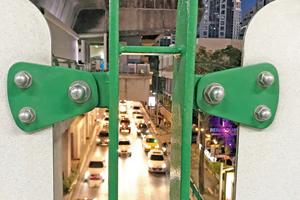Imagine two growing cities both full of construction activities. Why would one of them be more dusty than the other?


If you're sharp-eyed about rivets, you'll know that dust gathers on the top half, but not on the bottom. Pic Courtesy/CYâu00c2u0080u00c2u0088Gopinath
ADVERTISEMENT
In the house where i lived in Andheri Lokhandwala, I'd wipe a finger along the window sill in the morning, and a layer of dust would come away. The domestic help would wipe it clean every morning; 24 hours later, it would be grimy again.
But it was 1982, we were children then and had simple theories about things. Mine was that with so much crazy construction going on in Lokhandwala Complex, well, what would you expect if not clouds of dust? And thus, dust became another little thing we stopped questioning in Bombay. And then Bombay became Mumbai. But the dust remained dust.
I wouldn't be writing this today if I hadn't moved to Bangkok, on work first, but finally just to live. And the questions began coming. Bangkok and Mumbai are very similar, both urban, crowded and sleepless world cities with local life and culture richly woven into cosmopolitan sensibilities. Question 1 was why Bangkok didn't have swarms of flies despite being the world's street food capital. I wrote about that in this column on April 17.
The second question was why my window sills never got dusty in Bangkok — or more accurately, why nothing ever got dusty in Bangkok. After a hard day's toil, you could wash your hands clean without creating rivulets of grime.
I began paying special attention to public places where you'd normally expect dust. For example, on the outside of pedestrian overpasses across busy streets, large hexagonal rivets hold down steel barriers left and right of the walkway. If you're sharp-eyed about rivets, you'll know that dust gathers on the top half, but not on the bottom.
So I began checking Bangkok's outside rivets: they sparkled like freshly painted. And not because it had rained either. Next, I checked those ugly black nests of telephone and electricity cables that hang between lamp posts — another place where dust, cobwebs and pigeon s**t build up. In Bangkok, they were spotless. A week later, I saw several old women in municipal uniform with mops and swabs whose job apparently was to specifically clean dust and grime from all hard-to-reach places. Such as rivets on the outside.
I checked out one of Bangkok's many construction sites, which process the same materials as any Indian site — gravel, cement, bricks, concrete mixers. But miracle of miracles, no dust, thanks to the simplest of strategies. One worker on the site has just a single, simple task all day: he stands with a hose pipe watering the grounds every 15 minutes. Damp dust doesn't fly.
ON MY NEXT VISIT to Mumbai, I became a student of dust. Building construction sites are not the only dust devils. Major culprits are the mounds of debris that lie where utility companies have dug up the earth to lay cables. Since their job is not road cleaning, they leave the debris where it is when they're done.
By the time the department for debris-removal has slowly moved its creaky bones, passing winds have stirred the dirt and dust and blown it everywhere. The debris-removers finally come, but they do not fix the road, since that it is the roadworks department's job.
Meanwhile, more winds blow more dust around. In most cases, the roadworks people never show up. Mumbai has looked like a war zone as long as I've lived there, a bit like Aleppo after some barrel bombs.
And then I noticed another little dust-maker: the cute zig-zag paving tiles that give many Mumbai crossroads a faux European look. With just some basic geometry, you'd have seen the glaring mismatch between the kerb and the pavestones. The kerb is a straight edge, while the paisley tiles are curved.
When a curved object meets a straight one, gaps are guaranteed. A good road maker would know what to do about those gaps. He'd pack them tight with concrete cement, and they'd be gap-free when it dried. But Mumbai's heritage is of roads with beautiful tiles that are abandoned inches before they touch the pavement. Those are the tiles that go loose first, exposing dusty road. One by one, the rest follow.
Soon, the happy roadmaker has to be re-hired to repair his own work. Meanwhile, more and more dust flies around as more and more tiles come loose. I ASKED A ROADMAKER why his work was so shoddy. He shrugged and said, "It's how the system works. To win the contract, I have to pay someone in the municipality first, almost one-third of the amount. But after that, I don't have enough money left to deliver the job as I promised once I deduct the bribe and my profit. So I have to cut something somewhere. We just leaves the edges incomplete." And voila! Another cloud of dust.
Here, viewed from there. C Y Gopinath, in Bangkok, throws unique light and shadows on Mumbai, the city that raised him. You can reach him at cygopi@gmail.com Send your feedback to mailbag@mid-day.com
Catch up on all the latest Mumbai news, crime news, current affairs, and also a complete guide on Mumbai from food to things to do and events across the city here. Also download the new mid-day Android and iOS apps to get latest updates
 Subscribe today by clicking the link and stay updated with the latest news!" Click here!
Subscribe today by clicking the link and stay updated with the latest news!" Click here!






